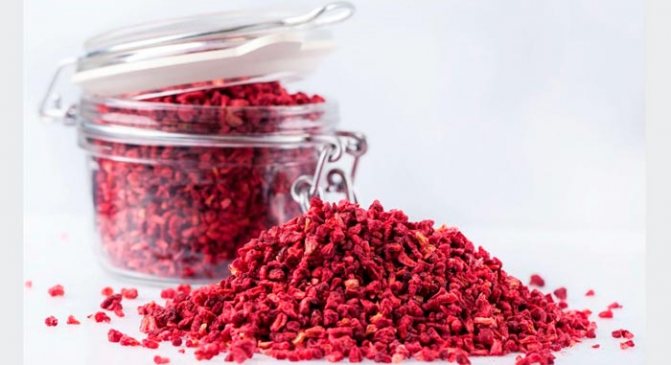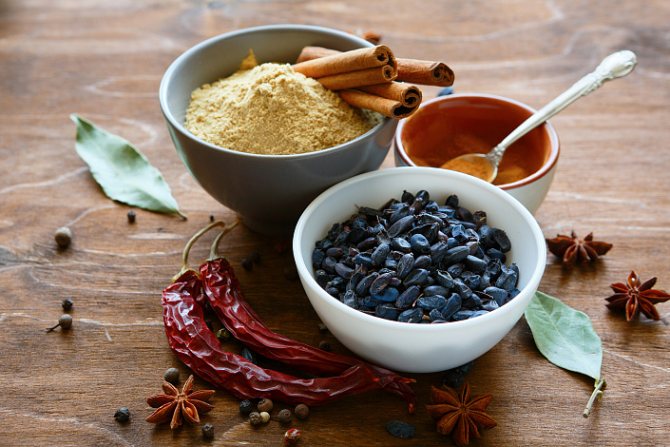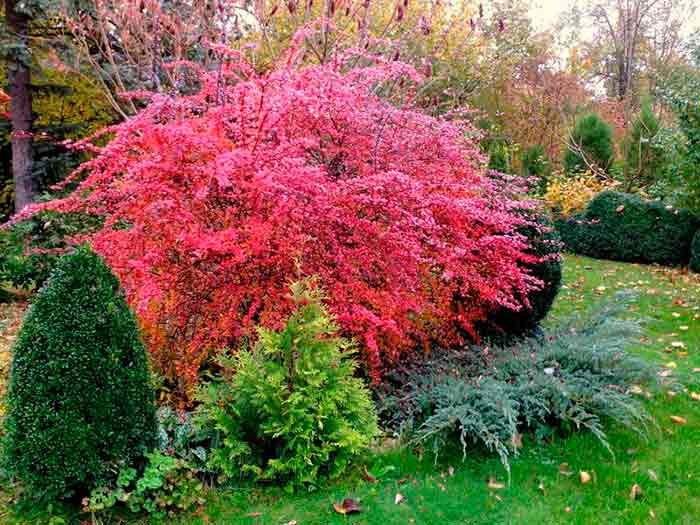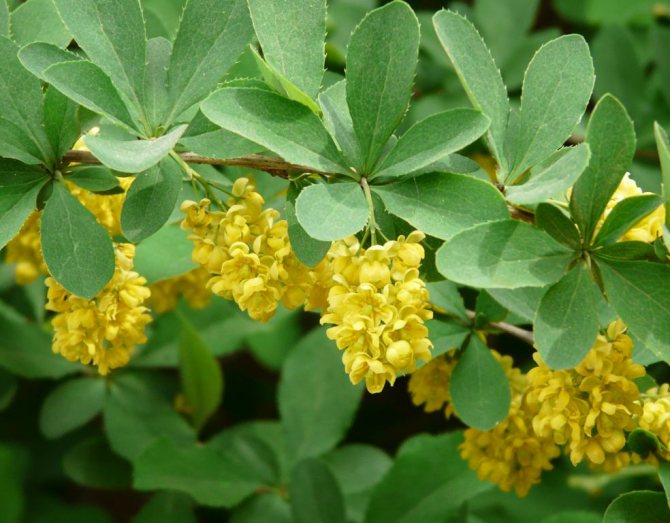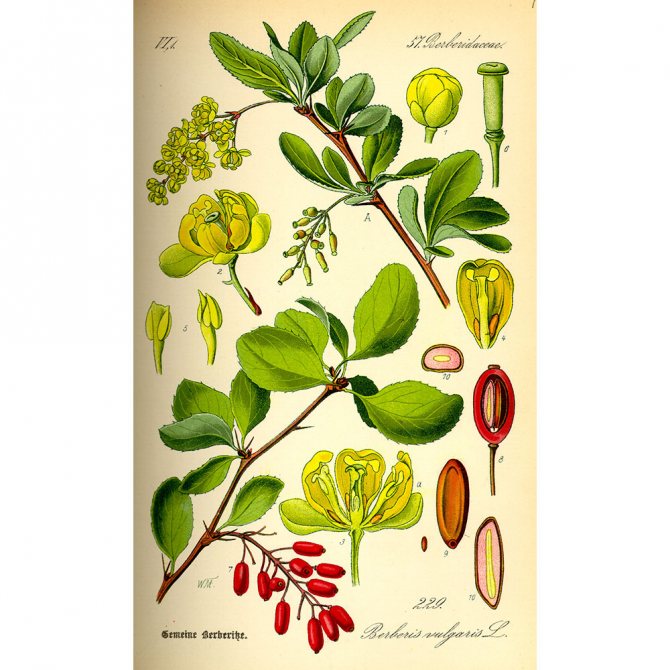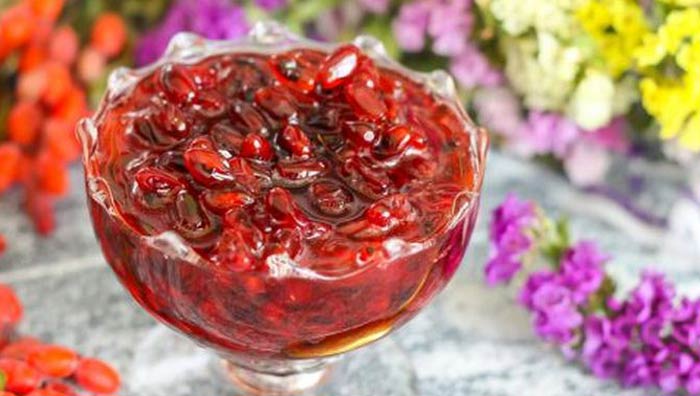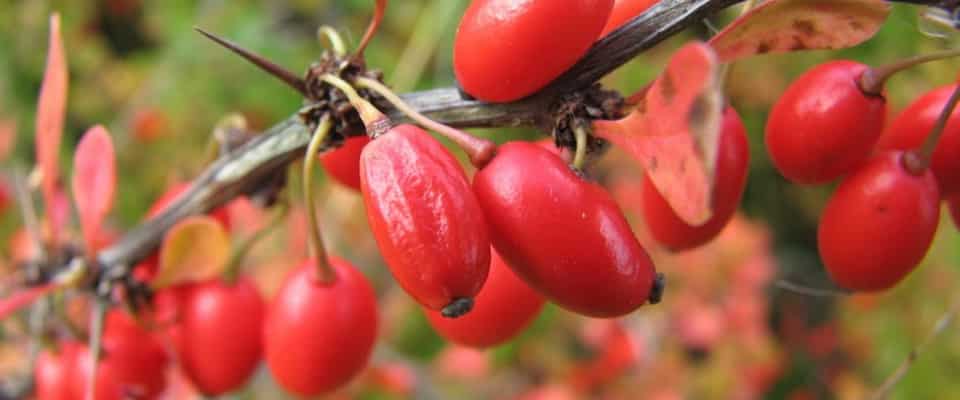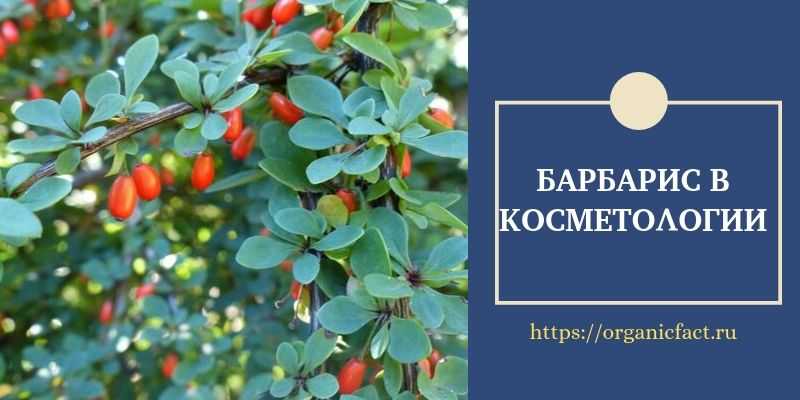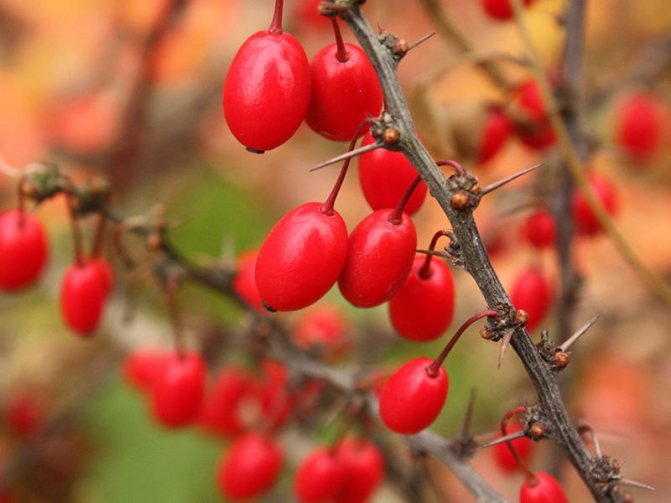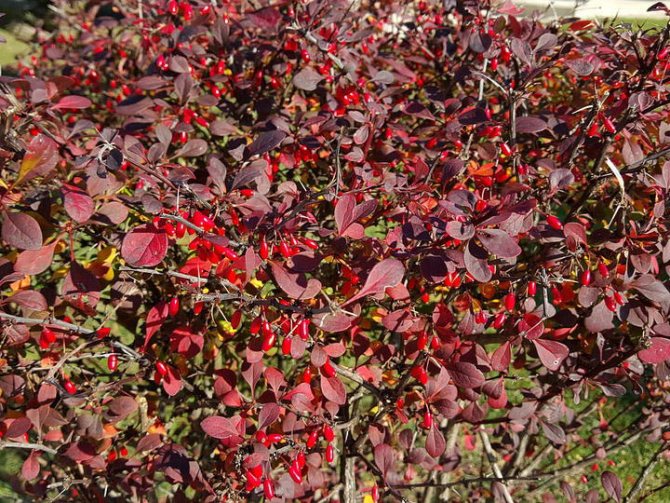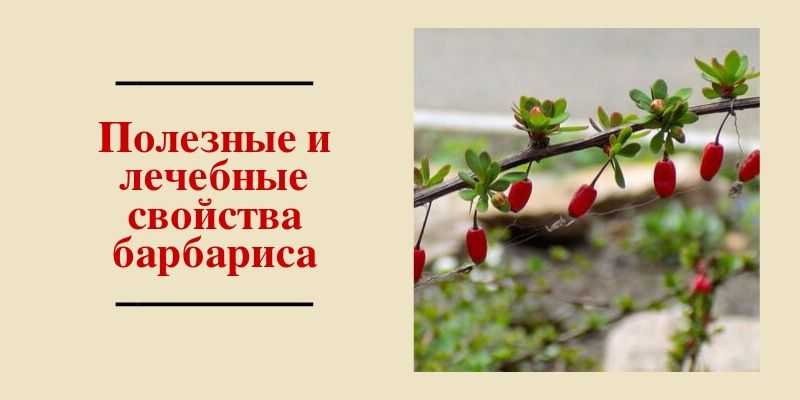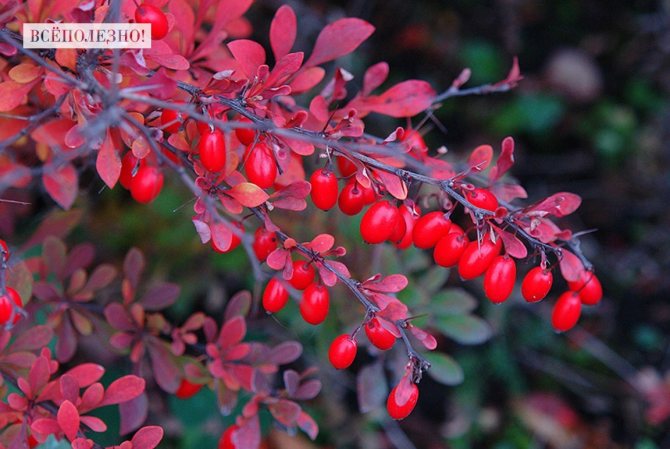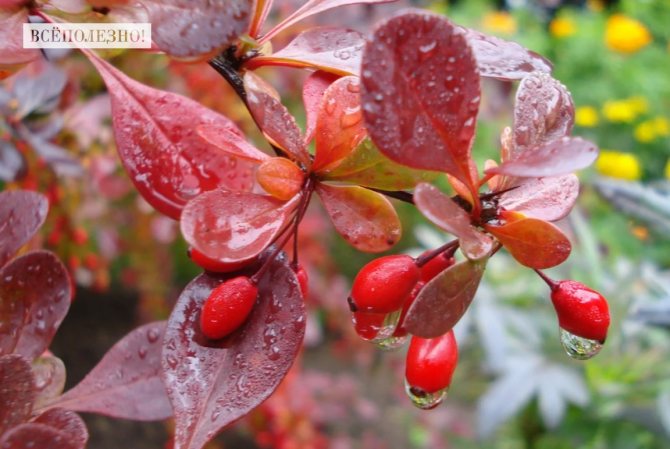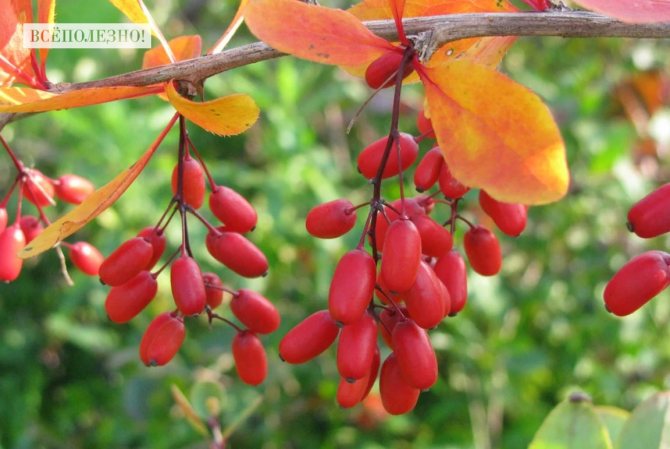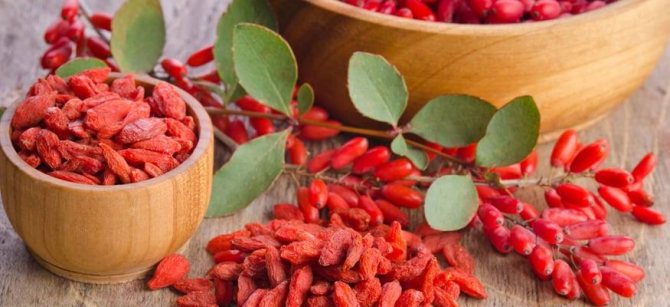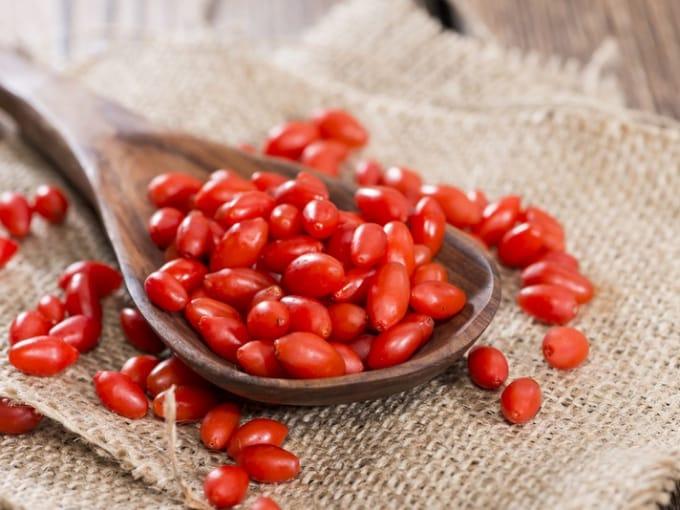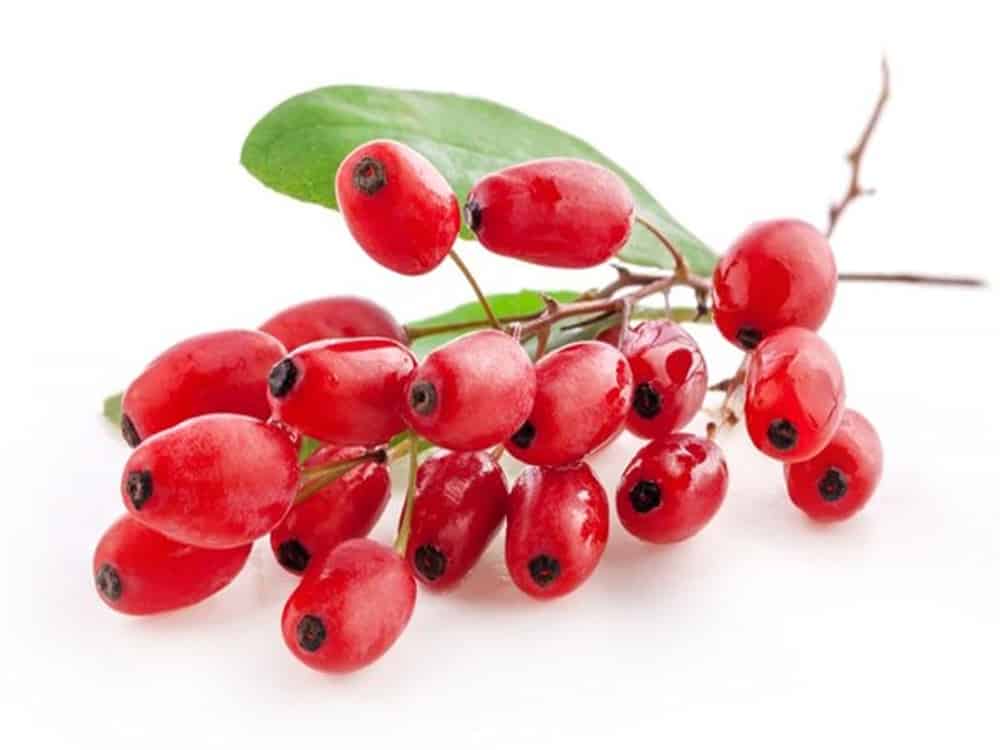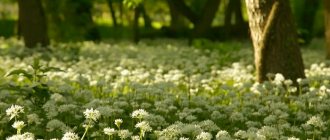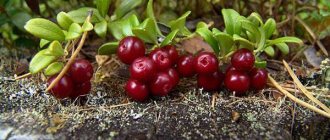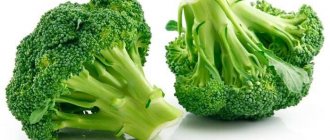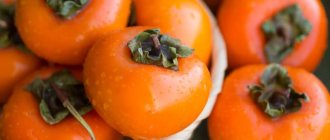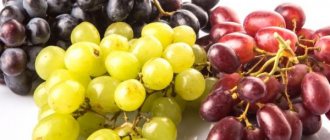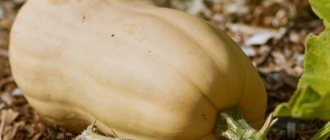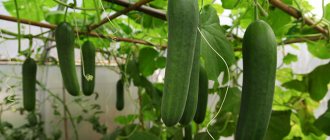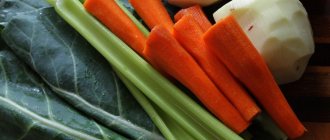The name barberry came from the New Latin “berbaris”, which came from Arabic in the 17th century (“berbaris” means “Berber shell”). The shrub is so named due to the similarity of the shape of the berries to this type of shell. Another variant of the origin of the word is from lat. "Berberi" - "bear berry", because it grows, as a rule, in the wild and is one of the treats of clubfoot. Barberry has over 175 species.
In the people, due to its pronounced sour and tart taste, barberry was nicknamed "sour" or "sour thorn". Often there are such names as "poklun" and "alum"; in Abkhazia the plant is called "Akatskhur", and in Armenia - "Tsor".
Barberry is a tall shrub (up to 2-3 meters), sometimes in the form of a tree with many curved thorny twigs, a thorny stem and a creeping rhizome (an underground shoot growing horizontally in the upper layer of the soil). The root system is well developed.
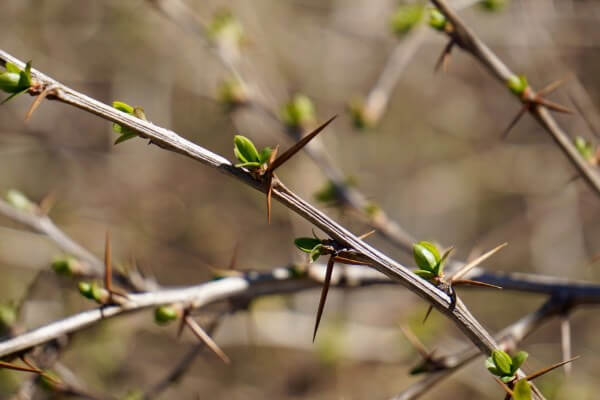
Photo: shoots of Barberry with thorns
The bark is light brown, sometimes brown. In different places of growth, there is a bark of red, purple and variegated colors.
The kidneys are usually sharp, bare, only up to 1 mm long. The shoots of the plant are erect, have edges, the color is yellowish or purple-yellow, later they turn white-gray. Thorns grow on elongated shoots, and ordinary leaves develop on shortened ones.
The leaves are small, oblong, very thin, slightly pointed at the top. In length up to 4 cm, and in width - about 2 cm, spines grow 1-2 cm long.The brush is formed from inflorescences of 15-20 flowers, the diameter of which is from 6 to 9 mm, and the length is about 6 cm. At the base of the flower - light orange nectaries.
The fruits of barberry are oblong, elongated berries, with a slight waxy bloom, the color of which varies from bright red to purple and scarlet, it is extremely rare to find black fruits. They grow in length from 12 mm to 2 cm, and the weight of one berry is only 4 grams.
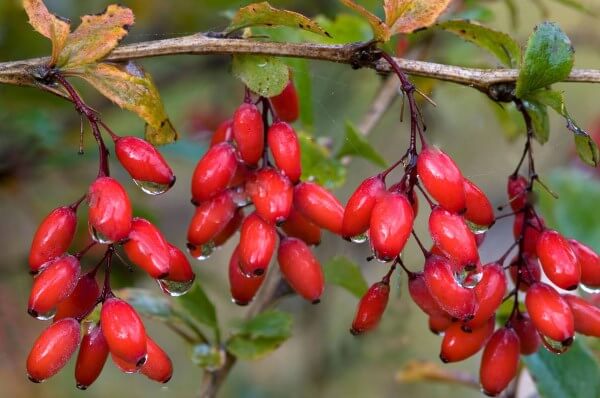

Photo: Barberry on a branch
The shrub blooms at the end of May, the berries ripen from August to September and remain on the bushes until October-November.
The shrub grows in almost all European countries. Mainly in the Transcaucasia, Western Asia, Eastern, Southern and Central Europe. It covers almost the entire territory of Ukraine and Crimea. In Russia, barberry is found in the European part and in the North Caucasus.
The habitat of the plant is considered to be the forest-steppe zone, but it can often be found in forest glades, forest edges, as well as on rocky slopes (up to 2,000 m high) and hillocks. Less commonly found in river floodplains and on pebbles.
The shrub settles on well-lit and dry plots of land, although it is not particularly pretentious to the soil, it calmly tolerates heat and cold.
a brief description of
The name of the culture comes from "beiberi", which means "shell-shaped" in Arabic. The plant covers approximately 170 species, some of which are grown by gardeners.
How does it grow?
Barberry is cultivated in the European part of Russia, in the Crimea, in the Caucasus. Also, the plant can be grown in the forest-steppe zone.
Common barberry can be found on hills, in sparse forests, on rocky slopes, glades and forest edges.
Also, the shrub can be cultivated as an ornamental plant.
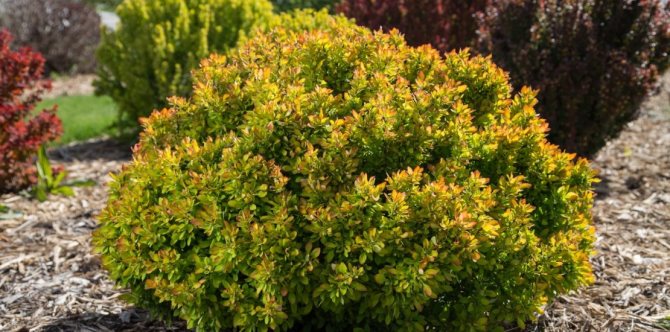

How does it bloom?
The flowering period for barberry begins in April-May. On the plant, brushes are formed, consisting of 25 flowers, painted in a yellow tint. The shrub blooms for 21 days.
This culture is a good honey plant. Very sweet and fragrant honey can be obtained from the pollen of barberry flowers.
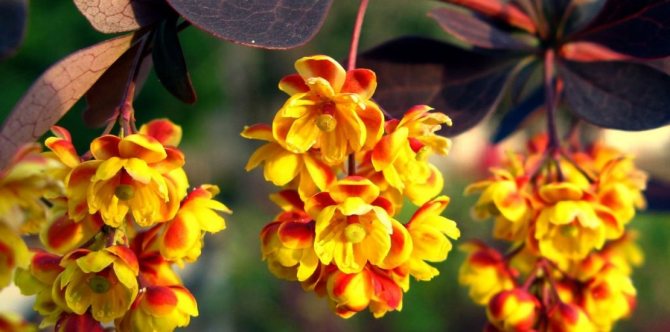

What does it look like?
Barberry is a highly branched bush with thorns that can reach almost three meters in height. The roots are cylindrical in shape, can be either curved or straight. The root system produces a lot of root growth.
The branches are covered with thorns, the length of which is 2 centimeters. In the first year, young branches have yellow bark, then it turns gray.
The leaves are placed on short shoots in the axils of the thorns. It tastes sour. The shape of the leaves is thin, narrowed towards the petiole. The outside is dark green and the bottom is lighter. With the arrival of autumn, the leaves turn bright scarlet.
The flowers are small in size, collected in a brush, have a rich aroma. Each flower consists of six oblong light yellow petals.
Fruits are oblong, cylindrical, approximately 1 centimeter long. Red berries, sour taste. The fruit pulp contains about 3 elongated seeds.
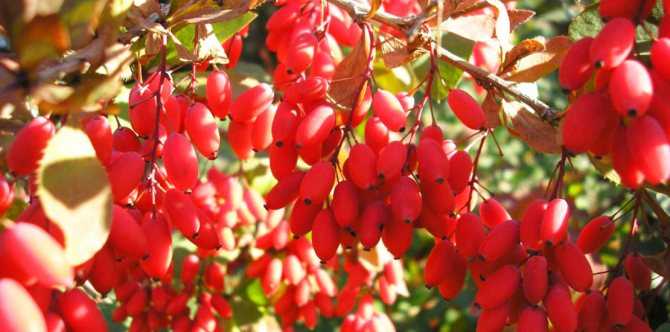

Are barberries edible?
Not all barberry berries are tasty or edible. You can eat only common and Amur barberry. Ottawa barberry and tunberg are inedible. There is a strong bitterness in their aftertaste. Also, the berries contain alkaloids (substances that provoke bitterness), which negatively affect the human body.
Taste
The fresh fruit of barberry tastes sour, with hints of astringency. At the same time, depending on the variety, the taste can acquire sweetness or salinity.
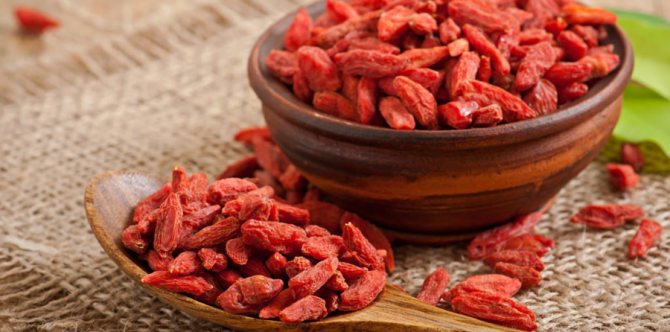

Smell
The berries of the plant smell pretty good. Their aroma is distinguished by a special spice that cannot be compared with anything else.
When to collect?
Harvesting mainly occurs at the beginning or end of autumn. The collection time depends on the ripening time of a particular shrub variety.
How to determine the maturity of barberry berries? Until the end, the ripe fruits should acquire a bright red color, and they should also be firm and firm to the touch. If the berries are overripe, they become soft, crumple easily, and also acquire a dark red hue.
In what month to collect barberry berries? In central Russia, the collection period falls in mid-August-early September. In the southern regions, the fruits ripen by early August. Also, the berries can hang on the bush until November, so during this period they are also harvested.
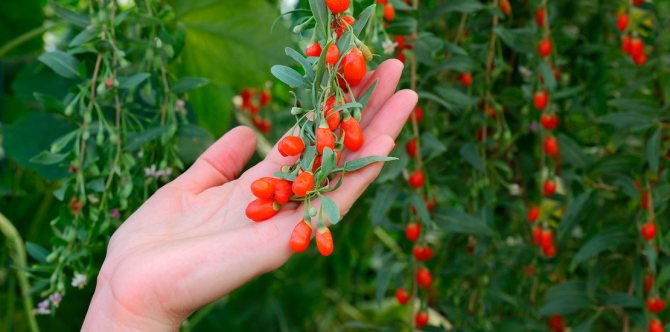

Procurement and storage of raw materials
Correct collection and storage of raw materials is of great importance. Barberry is a rather thorny shrub, so before harvesting, you need to properly equip yourself - tight gloves, closed clothes with long sleeves, and so on. The timing of harvesting for different parts of the plant is different:
- Blank roots held in April or November (during the dormant period). The volume of the dug roots should not exceed one third of all the roots of the plant (re-harvesting of the roots of the same plant is possible in at least five years). The roots are cleared of soil, rotten or blackened areas. It is categorically impossible to wash - berberine will be washed out.
- Fruit harvested in September-November. Only ripe fruits of barberry are subject to collection - they have the most pronounced beneficial properties (immature or greenish berries contain many alkaloids).
- Bark harvested in April-May. In spring, it is easily removed from the shoots (using longitudinal and transverse cuts).
- Leaves (whole, not damaged by diseases or pests) are harvested by hand (tearing off, as a rule, young tops with leaves) in May - June.
The collected raw materials are dried: they are laid out in one layer under a canopy (or in dryers) with good air ventilation. A sign of fruit readiness is the non-stickiness of berries, if you take a handful with your hand. Correctly dried roots have a lemon color at the break, a barely noticeable smell and a bitter taste. Dry raw materials are stored in cardboard boxes, paper or linen bags for no more than two years (roots - three years).
How is it different from other berries?
Externally, the common barberry is similar to other berries such as goji, dogwood and tunberg barberry. However, there is still a difference between these plants. It manifests itself in the smell and characteristics of the cultivation.
From barberry tunberg
The common barberry, unlike the tunberg, is not an ornamental crop. In addition, some species can reach 4 m in height, while the height of the tunberg does not exceed 2.5 m.
In Tunberg, the color of the fruit can be varied (orange, coral, scarlet). The berries of the common barberry are always scarlet.
Thunberg, unlike ordinary ones, is resistant to infections (powdery mildew, rust) and a dry climate, not capricious to the type of soil.
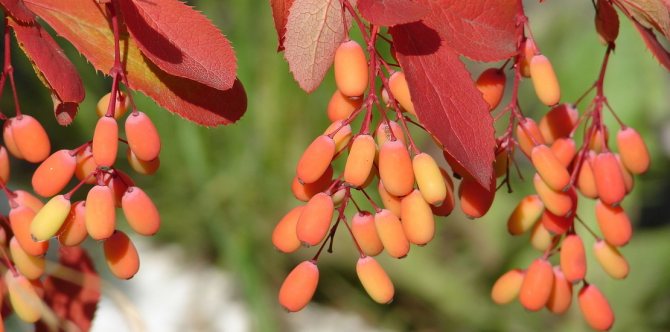

From dogwood
Dogwood and barberry differ from each other in all respects.
- These plants belong to different families, so they have different chemical compositions of berries and other parts.
- In barberry fruits, there are several soft small seeds (about 3-5 pieces), and in dogwood there is only one bone, hard to the touch, oblong in shape and large in size.
- Although both plants are used in folk medicine for the preparation of medicines, they are used to treat various diseases.
Even the color of the dogwood is different from the barberry. You will notice that the first has a more saturated hue.
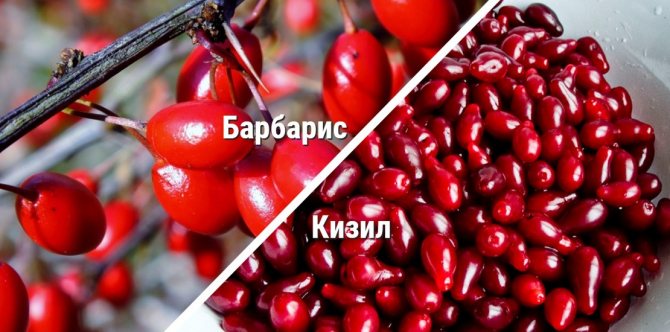

From goji berries
Distinguishing barberry from goji berries is quite simple. The fruits of the first are round, and the goji berries are oblong. Barberry berries are colored in a rich maroon hue, while goji's are dominated by carrot red. Plants also differ in taste. The barberry is sour, and the goji berries are sweet with a slight hint of sourness.
Goji are grown only in China, and barberry can be found everywhere. The leaves of the latter are oval, while in goji they are oblong. The flowers of the barberry are yellow, and the flowers of goji are purple.
After drying, goji berries retain their color and original shape. Barberry becomes round and dark.
The difference between the two berries is also in the price. Barberry is much cheaper than goji.


Barberry: photo and description
Barberry is a thorny shrub plant that grows up to 2.5 meters in height. During the flowering period, this representative of the flora world looks quite attractive. Ripe berries are oblong and bright red in color. They are used in cooking as well as in herbal medicine.


The plant blooms from April to May, with small, yellow flowers, collected in inflorescences. Barberry is considered an excellent honey plant. The fruits ripen from September to October, one berry weighs, on average, 4 grams.
This shrub grows throughout Central Asia and in southern and central Europe, it can be found in the east of Siberia and in North America. Also, the range of this plant is the Caucasus Mountains and the Crimean Mountains. Some biologists are sure that they are the birthplace of barberry.
Unripe berries should not be consumed, since they contain many alkaloids harmful to our body.
Types and varieties
Today, barberry has a fairly large number of both species and varieties. The most famous plant varieties are:
- Amursky. The bush is 3.5 m in height, so this type of culture is not very much in demand among gardeners. In the warmer months, the foliage has a green tint, and in the cold months it becomes golden-red. Blooms in late spring.
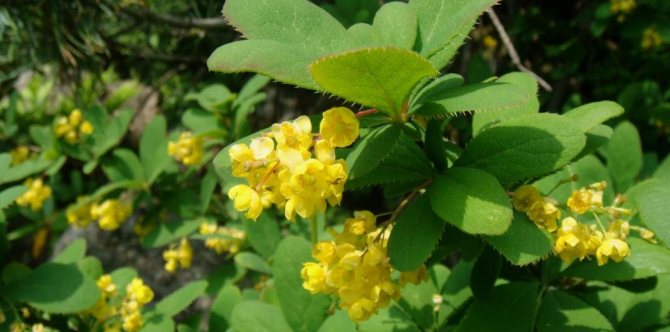

- Common barberry. Cultivated in Europe, Western Asia and the Caucasus. The shrub reaches 2.5 m in height.White or yellowish flowers bloom in May-June. Blossom for about 20 days. It is consumed as food.
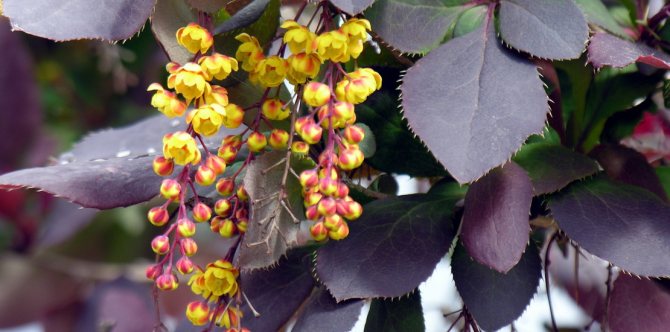

- Ottawa. Acts as a decorative look. The inflorescences are reddish yellow, and the leaves are lilac. In the colder months, the foliage has a purplish hue. The bush blooms in late spring. The flowering period lasts two weeks.
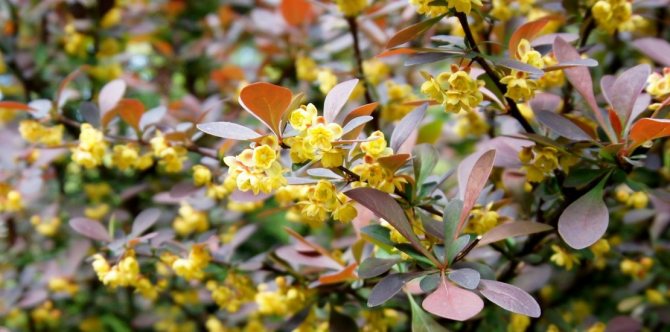

- Thunberg. Decorative variety. Grows on the slopes of Japan and China. It grows up to 1.5 m. In the warm months, the foliage is red or yellow, and with the arrival of autumn, the color changes to brown. Inflorescences are yellowish, reddish at the edges. Flowering lasts 12 days. Berries are not eaten because they taste bitter.


Amur barberry varieties:
- "Zhaponika" (bush 3.5 meters, yellow flowers, golden leaves);
- "Orpheus" (height is only 1 m, foliage is light green, cannot bloom).
Common barberry includes the following varieties:
- "Aureomarginata" (one and a half meter bush, green foliage, framed by a golden border around the edges);
- "Juliana" (a three-meter bush, green leaves become saturated scarlet color by autumn).
Ottawa barberry is represented by the following varieties:
- "Auricoma" (two-meter bush, reddish flowers with foliage);
- "Purpurea" (two-meter plant, purple foliage, yellowish-red flowers);
- "Superba" (height 2.5-3 meters, in summer the leaves are reddish with a blue tint, and in autumn the color changes to orange or bright red, yellow-red flowers, bloom in May, berries ripen by October).
Thunberg barberry is known for the following varieties:
- "Atropurpurea" (two-meter bush, purple foliage, flowering occurs in June and lasts 12 days, berries are formed in October);
- "Aurea" (80-centimeter bush, light orange leaves, yellow flowers, red at the ends, bloom in May for 14 days, fruits are formed in September);
- "Bagatelle" (40-centimeter bush, in the summer the foliage is brown, and in the autumn - red, fruiting begins in October, the variety is planted in the garden as a hedge);
- "Golden ring" (a three-meter shrub, the color of the leaves can be either yellow or red, yellowish flowers with a red edging bloom in May, and berries - in October);
- "Nana" (the height of the bush is 50 cm, the flowers are yellow, and the leaves are red, flowering begins in May, the berries ripen by October).
Of course, there are many more varieties and varieties of culture that are of interest. Each type of barberry has its own characteristics. The choice of shrub will depend on the goal of the grower.
How to store at home?
It is necessary to store fresh barberry berries at home either in the refrigerator compartment, or in a sufficiently dry and cool room. At room temperature, the fruits will begin to rot quickly.
However, the best way to store the product is to dry the berries. In this form, the shelf life of barberry can reach 2 years. In this case, the fruits should be placed in a tissue bag.


How to remove bones?
There are two ways to remove seeds from barberry berries. In the first version, the fruit is cut in half, and then the bones are extracted with a knife or fingers. In this case, everything must be done very carefully so as not to remove a large amount of pulp together with the bones.
The second option involves boiling barberry. After that, the fruits are ground through a sieve. In this case, the bones will remain on the surface. This method is suitable for jams and preserves.
Which of these options is better, it is impossible to say unequivocally, since in both the first and second cases you will have to spend a lot of patience and time.
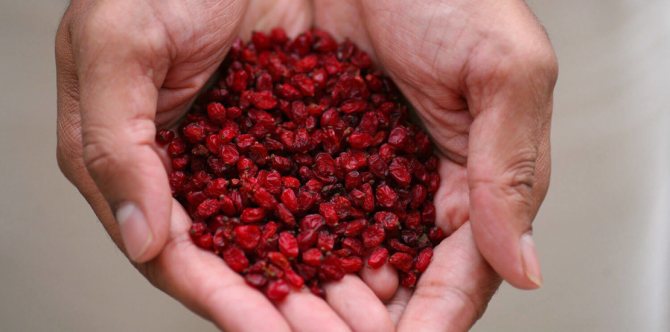

Vitamin composition
Barberry has a rich chemical and vitamin composition, which includes vitamins B1 and B2, A, C, PP and carotene, as well as trace elements such as potassium, sodium, calcium, phosphorus and iron. The roots of the plant are rich in carotenoids and alkanoids.
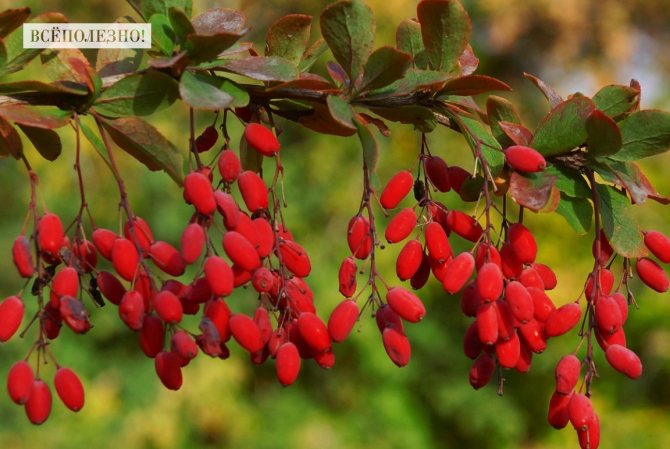

Energy value is 29.6 kcal. Per 100 g of fresh fruit.
Cooking use
Barberry fruits have found their place in cooking. The product is used for making syrups, jellies, juices, compotes, preserves and jams.
As a seasoning that adds sourness, dried and chopped barberry berries are added to meat dishes. For a rich taste, the product is placed in pilaf and kupaty (raw sausages).
Sour fruits are used in the production of liquor and wine. Unripe berries are pickled and salted.
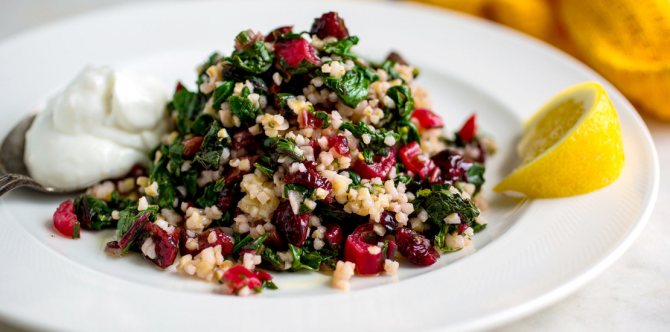

How to brew barberry?
Barberry tea is very beneficial for the body. This drink has a calming, choleretic, antimicrobial and antipyretic effect.
There are several ways to brew barberry:
- Pour a couple of tablespoons of fresh berries with water (you need 500 ml). The berries should be boiled in a water bath for 20 minutes. During cooking, some of the liquid will boil away. Therefore, after a specified period of time, the drink must be filtered by adding so much water that the volume is again equal to 500 ml.
- Steam a teaspoon of barberry with boiling water (250 ml) and leave to steep for 10 minutes. The drink can be drunk without diluting with water. This tea tastes rather sour, so you can add honey or granulated sugar to it.
- Pour a teaspoon of fresh berries with a glass of boiling water. The container in which the liquid is located should be wrapped. The drink is infused for 7 minutes. Then add honey and lemon juice (a teaspoon each) to the tea.
- Pour a teaspoon of dried fruits with a glass of boiling water, add a teaspoon of sugar. Brew for 10 minutes. Filter the drink. You need to drink the liquid warm after eating.
You can also brew black tea based on barberry berries. To do this, boil 600 ml of water. Wash and dry dried fruits. Add a tablespoon of black tea and 1.5 tablespoons of barberry to the teapot. Pour boiling water over the contents of the container and let it brew for 15 minutes. Ready tea is poured into mugs, where you can also add honey for sweetness.
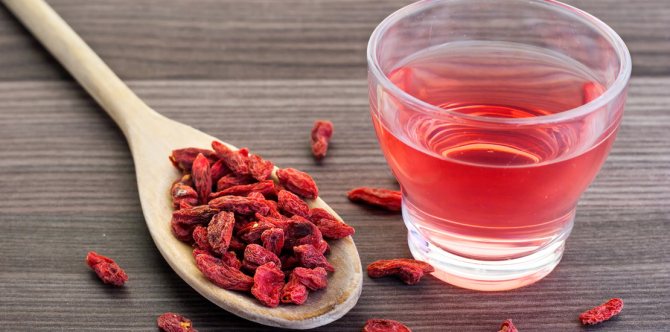

How to make compote?
Barberry compote perfectly quenches the feeling of thirst, and also has a beneficial effect on the body, strengthening the immune system. Also berry compote lowers blood pressure and normalizes digestive activity.
To make barberry compote, you must:
- Sort 200 grams of fresh berries thoroughly (remove leaves and stems), then pour completely with water and wash. The liquid will have to be changed several times in order to better clean the product from dust and dirt.
- Pure fruits must be folded into a deep saucepan, add 100 grams of granulated sugar and pour 800 ml of water.
- As soon as the liquid boils, the fire must be made quiet and the drink simmer until the berries give their taste, smell and color to the liquid.
- You can add some more sugar if needed. After that, the container with the compote must be wrapped in a warm blanket and left to infuse for 30 minutes.
- After the specified time, the barberry compote can be poured into glasses and served.
This compote can be preserved for the winter. For this, the ready-made hot drink is poured into sterilized cans and hermetically sealed.
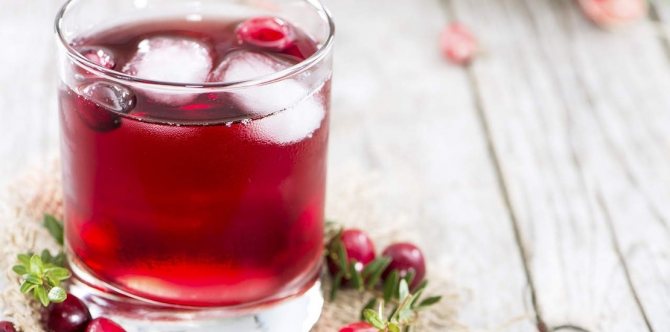

How to infuse berries?
Alcohol tincture of barberry is used to treat many diseases (for example, hepatitis, cholecystitis and gallstone disease). In addition, the drink improves appetite and normalizes the gastrointestinal tract.
You can insist barberry berries on any alcohol-containing basis. For these purposes, you can use vodka, alcohol or moonshine. Also, some cooks make barberry tincture on cognac.
On vodka
To insist berries on vodka, you must:
- Wash 200 grams of barberry, dry and put in a container. Pour 500 ml of vodka over the fruit.
- Close the container and put it in a dark and well-heated place for 15 days. The liquid should be shaken thoroughly every three days.
- After a specified period of time, it is necessary to put 3 clove buds, a cinnamon stick, a pinch of caraway seeds and an orange zest in the infusion.
- Next, you need to repeat all the same as in stage 2.
- Filter the composition and pour into a clean container.
- In a separate bowl, mix 100 ml of bottled water and 200 g of granulated sugar. Cook over low heat for 7 minutes, regularly removing the foam from the surface of the syrup. The composition should be cooled to room temperature.
- Mix the syrup with the infusion, distribute in bottles and put in a cold place for four days.
The strength of the barberry liqueur is 26 turns. The drink is stored for no more than 3 years. It is recommended to serve it with light snacks or desserts.


On moonshine
To make a barberry tincture on moonshine, you must:
- Carefully sort out the fruits, leaving only the ripe and whole ones in the amount of 150 grams. Then the berries need to be washed and crushed.
- Put barberry in a glass container and pour 2.5 liters of moonshine. Close the bottle and place in a dark place. The air temperature is +28 degrees.
- The liquid is infused for 15 days. Shake the drink daily.
- First, the liquid should be passed through a sieve, and then through a cotton-gauze cut.
- Add 150 grams of honey to the tincture and mix. After that, the drink must be poured into a clean bottle.
The barberry tincture should stand for three more days in a dark and cool room. After that you can taste it.
On alcohol
For the manufacture of barberry tincture on alcohol, it is recommended:
- Put one kilogram of fruit in a bag and put it in the freezer for two days. After that, the berries must be rinsed in warm water and placed in a jar. You also need to add 5 grams of vanilla sugar and a cinnamon stick.
- Dissolve 400 grams of linden honey in 400 ml of bottled water. Next, the mixture must be poured to the rest of the ingredients.
- Pour 800 ml of alcohol there. Close the container and put it in a dark and warm room for 60 days. Shake the contents of the jar daily.
- After the allotted period of time, the liquid should be removed from the sediment. The berries that remain at the bottom must be covered with sugar (100 grams) and removed to a dark and warm place for 5 days. Drain the resulting berry syrup.
- After that, the berry syrup must be mixed with an alcoholic infusion that was previously removed from the sediment. The resulting liquid is filtered.
Pour the tincture into bottles and send to a cold place for 6 months.
What to replace in the recipe?
In the recipe, barberry can be replaced with cranberries. She, like the described product, has a pronounced sourness in taste. This substitution will be appropriate in the preparation of pilaf.
In addition, some cooks use dogwood, raisins, prunes, cherry plum, tkemali, quince or sour plum instead of barberry. That is, those products that have a sweet and sour taste are taken to replace barberry berries.
You can add sumac or pomegranate to meat products instead of barberry.
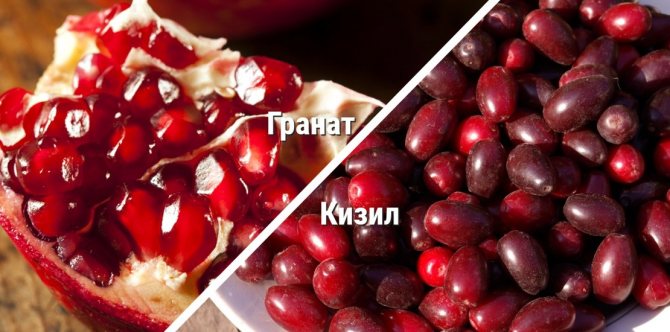

Harvesting barberry
So that you can enjoy barberry berries all year round, they can be prepared for the winter. For this, the fruits are either frozen or dried. In both cases, the product will retain useful substances, as well as taste and aroma.
How to freeze?
To freeze the barberry, fresh berries are sorted out, washed and dried so that excess moisture does not remain on the fruits.
Prepared berries are laid out in bags or plastic containers and sent to the freezer for storage. The shelf life of frozen fruits is about 3 years.
One package should contain as many berries as you can eat at one time. The product cannot be re-frozen, since it may lose its original appearance and taste.


How to dry?
Drying barberry, in principle, is easy and relatively quick. In addition, the shelf life of the workpiece reaches 2-3 years. At the same time, the same vitamins and minerals are preserved in dried berries as in fresh ones.
There are several ways to dry barberry. However, all options start with one preparatory stage. The fruits are sorted out, spoiled and rotten ones are removed. Then the good berries are thoroughly washed and dried.
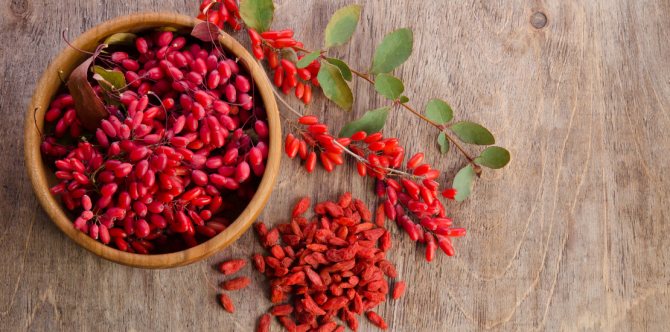

In the oven
To dry the product in the oven, you must observe the temperature regime. The cooking process consists of the following steps:
- The prepared berries are laid out on a baking sheet covered with parchment paper and placed in an oven preheated to 50 degrees.
- As soon as juice is released from the barberry, the temperature should be increased to 60 degrees.
- During the drying process, the berries must be mixed periodically.
- After 2.5 hours, the barberry will be ready.
Dried fruits, when squeezed, should not release juice.


In the microwave
To dry barberry in the microwave, you will need:
- Arrange fresh fruits between two paper napkins and place on a plate.
- The blanks are sent to the microwave for a couple of minutes. The power should be 200 watts.
- After the specified time, the berries must be checked for readiness. If the product needs to dry a little more, the oven should be turned on for 30 seconds, setting the same power as it was originally.
- It is best to dry barberry in several passes, each time checking the readiness of the product.
Well-dried fruits should remain soft, but juice should not flow out of them.
In an electric dryer
Drying barberry berries in an electric dryer is a bit like drying a product in an oven. After the preparatory stage, the fruits are dried for 3 hours at a temperature of +50 degrees.
After that, the mode increases to +60 degrees, and drying continues until the berries are fully cooked.
The surface of the dried barberry should be glossy. When squeezed, no liquid should come out of the fruit.
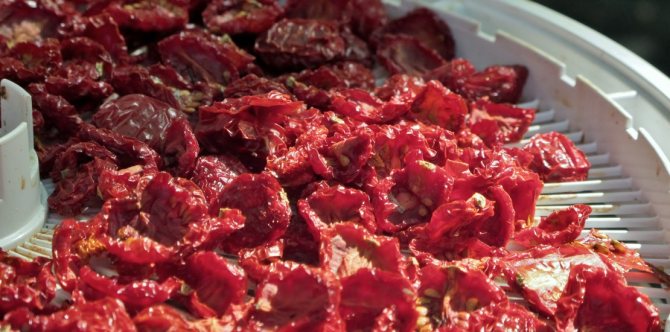

Benefits for the body
The barberry contains many vitamins, minerals and other equally useful substances (ascorbic acid, carotene, tocopherol, organic acids, tannins), which have a positive effect on the human body.
On the basis of the plant, medicines are made that help with a number of diseases, namely:
- pain in the heart;
- high blood pressure;
- hemorrhoids;
- dysentery;
- diseases of the liver, kidneys, gallbladder, spleen, mouth, eyes;
- malaria;
- uterine bleeding;
- pleurisy;
- elevated body temperature;
- rheumatism;
- diabetes mellitus;
- tuberculosis;
- scurvy.
In addition, barberry has a laxative, antiseptic, tonic, antipyretic and diaphoretic effect. Also, the plant is able to eliminate a strong wet cough, removing phlegm from the bronchi.
At what age is it allowed to give barberry to children? Experts do not recommend including the berries of the plant in the children's diet before the age of 12. Eating fruits can provoke poisoning in babies.


Women
Barberry will be useful for women both fresh and as part of decoctions and cosmetics. Berry face masks remove age spots and dead skin cells.
Decoctions based on barberry improve the general condition during menstruation, relieving lethargy. Also, folk remedies based on barberry increase the level of hemoglobin in the blood.
In addition, barberry is useful for losing weight. Compotes, juices are prepared from it, which help burn fat and improve metabolism.
Barberry is contraindicated not only in the early stages of pregnancy, but also during the entire period of bearing a child. The product contains alkaloids that can cause contraction of most muscles.Eating even a small amount of barberry during pregnancy can cause miscarriage, swelling or bleeding.


Men
It is useful for men to eat barberry and drink decoctions based on it to speed up sperm motility (especially if there are problems with conceiving a child), get rid of inflammatory diseases of the genitourinary system and prostatitis.
In folk medicine, to get rid of impotence, a special decoction is prepared based on wild rose and barberry, which increases blood flow to the pelvic organs, thereby increasing potency.
It is also recommended to drink berry drinks when playing sports. A drink based on barberry eliminates the feeling of fatigue and saturates the body with energy and strength.
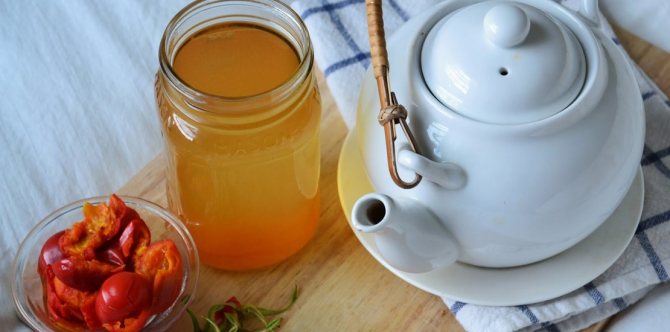

How is Barberry useful? Useful properties of this plant
Barberry has an extensive list of useful properties, therefore the area of its medicinal use is unusually wide. The main use cases include the following:
- as a natural antibiotic. The main active ingredient of this phytocomponent is berberine, which has antifungal, as well as antiprotozoal and antibacterial properties,
- to optimize the functioning of the gastrointestinal system. Penetrating into the smooth muscles of the stomach and other organs, Berberine relieves spasms and heals wounds and microdamages,
- as prevention of diabetes mellitus. Berberine is involved in lipid metabolism, and also affects blood glucose levels,
- to maintain a healthy heart. The main component of barberry relieves vascular spasms and improves blood flow. It is effective for ischemia, hypertension and VSD,
- to relieve metabolic syndromes. Barberry contains many antioxidants that normalize metabolic processes and enhance the body's resistance to free radicals,
- to cleanse the liver with the gallbladder. Berberine enhances the production of bile, and this helps to remove harmful cholesterol and toxins from the body,
- in the treatment of diarrhea. The astringent and antifungal properties of barberry allow you to quickly remove pathogenic microbes from the body and neutralize the consequences of their defeat,
- to improve eye health. The antibacterial properties of barberry help to get rid of conjunctivitis. It is also known that the main component of this herbal remedy strengthens the eye muscles,
- if necessary, strengthening the immune system. Berberine stimulates the production of white blood cells, which fight any disease causing bacteria and viruses,
- to improve the work of the female reproductive system. The antibacterial properties of barberry help in the treatment of vaginitis. This herbal remedy is indicated for too heavy and irregular menstruation and, as a result, anemia,
- with weight loss. Berberine cleanses the gastrointestinal tract system from toxins and reduces appetite,
- when fighting parasites. The antimicrobial qualities of barberry help cleanse the body of pathogenic and disease-causing bacteria and microbes,
- as a vitamin remedy. Barberry is rich in vitamins A and C, as well as organic acids.
Such an extensive list of useful qualities makes barberry an unusually valuable phytocomponent of traditional medicine.


To understand how to use it, you need to know about the methods of making medicines based on it. But, like any natural substance, it has its own contraindications and side effects. You need to familiarize yourself with them and take into account even before you start taking any medicine or product that contains barberry.
Healing properties
Due to its medicinal properties, barberry is widely used in folk medicine. Decoctions are prepared from the fruits, seeds, leaves, oil and even the roots of the plant, eliminating serious diseases. For example, with adenoids, barberry eliminates inflammation, and also destroys pathogenic bacteria.
However, despite its healing properties, barberry also has a number of contraindications (described below), which cannot be neglected so as not to harm the body. In particular, it is not necessary to abuse both the product and the medicinal products based on this plant.
Berries
For the preparation of broths, it is necessary to use only fully ripe barberry berries, otherwise you can cause severe poisoning. Often the fruits of the plant are used for the manufacture of medicines that help to strengthen the immune system. To do this, fresh berries are mixed with honey and eaten.
To get rid of colds, a decoction is being prepared. To do this, you need a couple of tablespoons of berries, pour half a glass of water and boil over low heat for 20 minutes. Then add enough water to the drink to get the initial volume. Take 50 milliliters three times a day.
Treatment of hemorrhoids with barberry berries also has a positive effect. It is enough to eat jam or a few fresh fruits a day to relieve the symptoms of the disease.
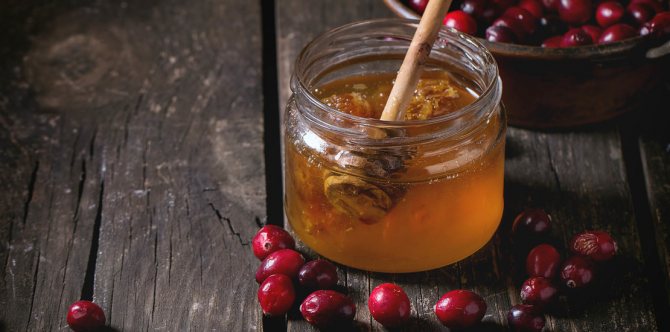

Leaves
Barberry leaves help get rid of colds. On the basis of this part of the plant, decoctions are made that eliminate a sore throat, and also soothe a paroxysmal cough.
As a choleretic and anti-inflammatory agent for diseases of the liver and gallbladder, leafy infusion of barberry is used. For these purposes, a couple of tablespoons of dried leaves are steamed in a glass of boiling water for about half an hour. The infusion is filtered and taken in 1 tbsp. l. four times a day. The course of treatment is 30 days.
Bark
Barberry bark is highly valued in folk medicine. On its basis, decoctions are prepared to help get rid of:
- diarrhea;
- gallstones;
- rheumatism;
- stomach cramps;
- cholecystitis.
Medicinal formulations based on the bark of the plant increase blood clotting. Therefore, decoctions are not recommended for people with heart and blood vessel problems.
For cholecystitis, hepatitis, inflammation of the gallbladder and kidneys, an infusion on the bark of the plant is used. To do this, 25 grams of bark is steamed with 400 ml of boiling water and insisted for 4 hours. The resulting infusion is filtered. Consume 100 ml 4 times a day for 30 days.
A decoction of barberry bark can cure conjunctivitis. To prepare the product, you will need a tablespoon of dried and chopped bark, pour 200 ml of hot water (the liquid should not boil). The composition languishes in a water bath for about 20 minutes. Then the product must be cooled and filtered. Lotions are made from the broth. The course of treatment lasts until complete recovery.
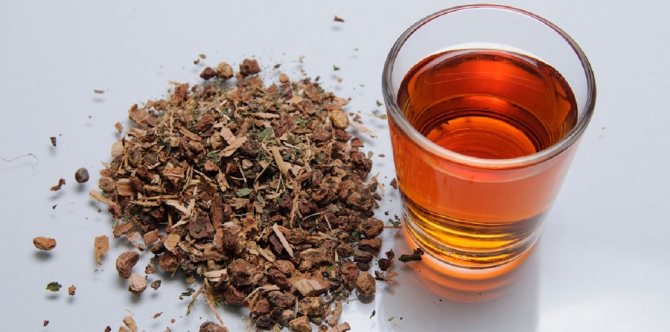

Roots
Barberry root has a choleretic effect, is able to normalize blood pressure, and also eliminate diarrhea.
In addition, the healing properties of the plant root are aimed at:
- normalization of the kidneys and liver;
- cleansing the body of toxins;
- increased blood clotting;
- strengthening of blood vessels.
For each type of disease, both decoctions and alcohol tinctures are used. The latter should be taken only after consulting a doctor.
Infusion of barberry root is used for liver diseases (hepatitis). To prepare a healing infusion, pour a couple of tablespoons of ground dry roots into a thermos and steam with 400 ml of boiling water. Insist for several hours and filter. Drink 100 ml three times a day for 30 days.
Also, the root of barberry helps to remove kidney stones. For this purpose, the following recipe is proposed: a mixture of ground barberry roots (50 g) and marshmallow (40 g), strawberry and birch leaves (20 g each), corn stigmas (20 g), pour a liter of water and boil for a quarter of an hour. Cool the composition to room temperature. Drink 150 ml three times a day. You can add a little honey to the broth.
In oncology, the barberry root prevents the development of metastases.To make a medicinal decoction, you need to take a teaspoon of dry root and bark of a plant, pour 200 ml of hot water and boil in a water bath for a quarter of an hour. Cool and filter the drink. Consume 2 tbsp. l. three times a day before meals.
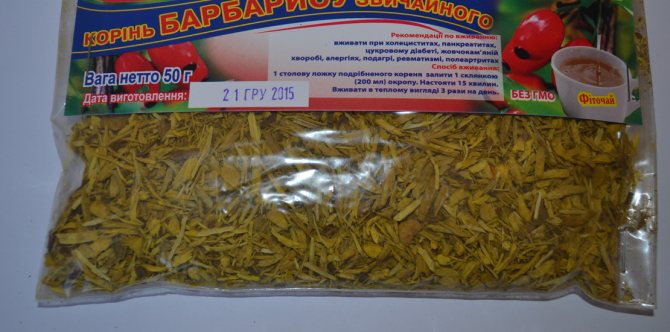

Barberry oils
The oil obtained from barberry has found application in cosmetology for:
- rejuvenation and tightening of the skin, smoothing of wrinkles;
- removal of the inflammatory process in the tissues;
- improving complexion, getting rid of freckles, acne and age spots.
In addition, essential oil of barberry cares for hair, eliminating dandruff and oily curls, strengthening strands and saturating hair roots with essential nutrients.
To keep your hair shiny, you can add a little barberry oil to the rinse or shampoo.
Also, the oil can be added to cosmetics for facial skin care. Due to this, the effect of the mask or cream will be much brighter.


What diseases does it treat
The benefit of barberry lies in the fact that it is increasingly used for the manufacture of medicines. Many pharmacies sell not only preparations containing this useful plant, but also its leaves, bark and roots. Pharmaceutical companies use these components to make medicines that help get rid of internal bleeding and normalize the work of the biliary tract. Also, official drugs containing barberry are prescribed for people suffering from cholecystitis, liver problems, and gallbladder problems. According to folk healers, barberry medications help even with cancer and diabetes.
Advertisement 1
Barberry for weight loss
The calorie content of barberry berries is not very high. On average, there are only 36 kcal per 100 grams of product. Therefore, barberry is recommended for use during the period of weight loss.
Subject to dietary nutrition, you can not only eat fresh berries, but also prepare tea and infusions based on the product.
How to use barberry fruits for weight loss correctly:
- If the product serves as a snack, the main meal should be no later than an hour after eating the berries.
- Dried barberry can increase your appetite. However, if the fruits are steamed, then this effect can be avoided.
- It is best to drink berry-based drinks to help fill the stomach, saturate the body and reduce the serving size.
To prepare tincture on barberry, you must:
- Put 20 grams of berries in a clean jar and pour 200 ml of alcohol.
- Place the container in a dark and cool place for 15 days.
- When ready, the liquid must be shaken well.
The tincture is taken in a teaspoon 4 times a day after meals. The course lasts 20 days. Then you need to take a 2-week rest.
To make tea with barberry, you must:
- Pour 100 grams of dried fruit with 200 ml of hot water.
- Cook the resulting composition over low heat for 20 minutes.
- Pour the finished drink into a thermos and set aside for infusion for 4 hours.
- Before drinking, tea is diluted with warm water in a ratio of 1: 2, respectively.
You need to drink a drink 70 ml 4 times a day 30 minutes before meals.
You do not need to make tea based on barberry for future use. It is enough to prepare a new portion of the drink at least once every two days. You can drink tea warm or cold. No granulated sugar is added. The only thing you can add is a lemon wedge or a mint leaf.
Experts strongly recommend not to consume any tea or tincture if diuretics are taken, as well as antibacterial or antihistamines.


The nutritional value
The nutritional value of barberry is extremely low. In addition to carbohydrates, this berry no longer supplements the total calorie content of the product.
| Useful substances in barberry | Content in 100 grams of berries |
| Protein | 0 g |
| Fats | 0 g Saturated fatty acids - 0.0 g Polyunsaturated fat - 0.0 g Monounsaturated Fat - 0.0 g |
| Carbohydrates | 7.9 g |
Harm and contraindications
With the abuse of fresh berries, as well as with prolonged use of infusions and decoctions based on barberry, colossal harm to the body can be caused.
In addition, the product is contraindicated for:
- allergies;
- varicose veins;
- high acidity of gastric juice;
- diseases of the kidneys, liver or gallbladder;
- heart disease;
- uterine bleeding;
- thrombophlebitis.
Also, do not eat unripe barberry. If the product is consumed in large quantities, convulsions, dizziness and nausea may occur. The daily norm of the product is 150 grams.
It is not recommended to give berries to children under 12 years of age.
Barberry for diseases
Barberry and products based on it have different effects on the course of various diseases. Therefore, before using barberry compotes, infusions, decoctions, etc., it is advisable to consult with your doctor.
Hypothyroidism
With a prolonged and persistent lack of thyroid hormones, experts allow the use of barberry berries, but only in small quantities, so as not to aggravate the condition.


Uterine bleeding
With uterine bleeding caused by menstruation or in the postpartum period, it is allowed to use barberry tincture. To prepare it, you need to pour 20 grams of leaves with 100 milliliters of vodka and leave for 15 days in a warm place. As soon as the drink turns dark yellow and acquires a sour taste, the tincture is ready. Consume 30 drops three times a day. The course of treatment is 2 weeks.
However, this drug is contraindicated to drink with gynecological bleeding or with the inflammatory process of the appendages.


Oncology
In oncology, traditional medicine experts advise using a barberry infusion based on the roots and bark of the plant. Such a medicine acts as an additional therapeutic agent that will help stop the malignant process in the body.
High blood pressure
Barberry is able to lower high blood pressure due to the vasodilating effect inherent in these fruits. The berries also contain ascorbic acid, which helps to strengthen the walls of blood vessels and prevent their fragility. In addition, barberry restores vascular tone, which has a positive effect on blood pressure.
With increased pressure, an infusion of barberry is taken. To make it, you need to pour a tablespoon of plant flowers with 300 ml of water. The liquid is boiled for 10 minutes, and then infused for 3 hours. The finished drink needs to be filtered.
Take a tablespoon before meals. The course of treatment lasts 30 days.


Cold
For colds, flu, as well as to strengthen the immune system, a decoction of barberry berries is taken. For these purposes, the fruits are used for the preparation of fruit drinks, compotes, jam or preserves.
To treat colds faster and more effectively, you need to drink the broth every day. If you drink the remedy only once, there will be no result.


Things to Remember
Barberry is a well-known plant in cooking and herbal medicine that has a number of beneficial qualities. The medicinal properties of barberry are very diverse and extensive. The method of preparing medicines based on it depends on the field of application. Which option to prefer - each person decides for himself. In addition, barberry berries have a very pleasant taste, juices and fruit drinks from them are not only healthy, but also very tasty drinks.
Article author Victoria Fesyura: “I study traditional medicine and home cosmetology, apply it in practice and share this information with readers. I wish you all good health. "
The article was read: 1,719

